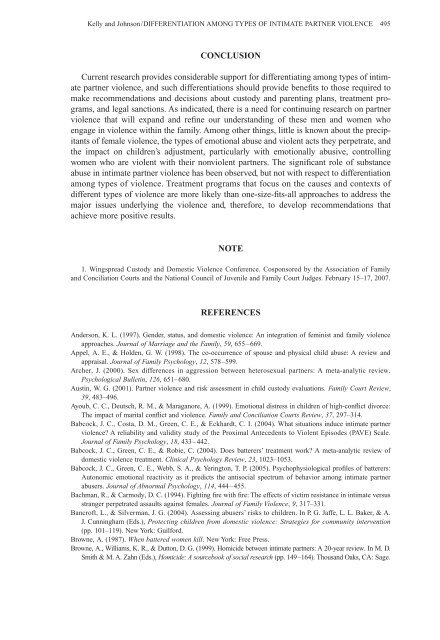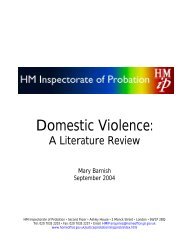differentiation among types of intimate partner violence - PAI Family ...
differentiation among types of intimate partner violence - PAI Family ...
differentiation among types of intimate partner violence - PAI Family ...
You also want an ePaper? Increase the reach of your titles
YUMPU automatically turns print PDFs into web optimized ePapers that Google loves.
Kelly and Johnson/DIFFERENTIATION AMONG TYPES OF INTIMATE PARTNER VIOLENCE 495<br />
CONCLUSION<br />
Current research provides considerable support for differentiating <strong>among</strong> <strong>types</strong> <strong>of</strong> <strong>intimate</strong><br />
<strong>partner</strong> <strong>violence</strong>, and such <strong>differentiation</strong>s should provide benefits to those required to<br />
make recommendations and decisions about custody and parenting plans, treatment programs,<br />
and legal sanctions. As indicated, there is a need for continuing research on <strong>partner</strong><br />
<strong>violence</strong> that will expand and refine our understanding <strong>of</strong> these men and women who<br />
engage in <strong>violence</strong> within the family. Among other things, little is known about the precipitants<br />
<strong>of</strong> female <strong>violence</strong>, the <strong>types</strong> <strong>of</strong> emotional abuse and violent acts they perpetrate, and<br />
the impact on children’s adjustment, particularly with emotionally abusive, controlling<br />
women who are violent with their nonviolent <strong>partner</strong>s. The significant role <strong>of</strong> substance<br />
abuse in <strong>intimate</strong> <strong>partner</strong> <strong>violence</strong> has been observed, but not with respect to <strong>differentiation</strong><br />
<strong>among</strong> <strong>types</strong> <strong>of</strong> <strong>violence</strong>. Treatment programs that focus on the causes and contexts <strong>of</strong><br />
different <strong>types</strong> <strong>of</strong> <strong>violence</strong> are more likely than one-size-fits-all approaches to address the<br />
major issues underlying the <strong>violence</strong> and, therefore, to develop recommendations that<br />
achieve more positive results.<br />
NOTE<br />
1. Wingspread Custody and Domestic Violence Conference. Cosponsored by the Association <strong>of</strong> <strong>Family</strong><br />
and Conciliation Courts and the National Council <strong>of</strong> Juvenile and <strong>Family</strong> Court Judges. February 15–17, 2007.<br />
REFERENCES<br />
Anderson, K. L. (1997). Gender, status, and domestic <strong>violence</strong>: An integration <strong>of</strong> feminist and family <strong>violence</strong><br />
approaches. Journal <strong>of</strong> Marriage and the <strong>Family</strong>,<br />
59,<br />
655–669.<br />
Appel, A. E., & Holden, G. W. (1998). The co-occurrence <strong>of</strong> spouse and physical child abuse: A review and<br />
appraisal. Journal <strong>of</strong> <strong>Family</strong> Psychology,<br />
12,<br />
578–599.<br />
Archer, J. (2000). Sex differences in aggression between heterosexual <strong>partner</strong>s: A meta-analytic review.<br />
Psychological Bulletin,<br />
126,<br />
651–680.<br />
Austin, W. G. (2001). Partner <strong>violence</strong> and risk assessment in child custody evaluations. <strong>Family</strong> Court Review,<br />
39,<br />
483–496.<br />
Ayoub, C. C., Deutsch, R. M., & Maraganore, A. (1999). Emotional distress in children <strong>of</strong> high-conflict divorce:<br />
The impact <strong>of</strong> marital conflict and <strong>violence</strong>. <strong>Family</strong> and Conciliation Courts Review,<br />
37,<br />
297–314.<br />
Babcock, J. C., Costa, D. M., Green, C. E., & Eckhardt, C. I. (2004). What situations induce <strong>intimate</strong> <strong>partner</strong><br />
<strong>violence</strong>? A reliability and validity study <strong>of</strong> the Proximal Antecedents to Violent Episodes (PAVE) Scale.<br />
Journal <strong>of</strong> <strong>Family</strong> Psychology,<br />
18,<br />
433–442.<br />
Babcock, J. C., Green, C. E., & Robie, C. (2004). Does batterers’ treatment work? A meta-analytic review <strong>of</strong><br />
domestic <strong>violence</strong> treatment. Clinical Psychology Review, 23, 1023–1053.<br />
Babcock, J. C., Green, C. E., Webb, S. A., & Yerington, T. P. (2005). Psychophysiological pr<strong>of</strong>iles <strong>of</strong> batterers:<br />
Autonomic emotional reactivity as it predicts the antisocial spectrum <strong>of</strong> behavior <strong>among</strong> <strong>intimate</strong> <strong>partner</strong><br />
abusers. Journal <strong>of</strong> Abnormal Psychology, 114, 444–455.<br />
Bachman, R., & Carmody, D. C. (1994). Fighting fire with fire: The effects <strong>of</strong> victim resistance in <strong>intimate</strong> versus<br />
stranger perpetrated assaults against females. Journal <strong>of</strong> <strong>Family</strong> Violence, 9, 317–331.<br />
Bancr<strong>of</strong>t, L., & Silverman, J. G. (2004). Assessing abusers’ risks to children. In P. G. Jaffe, L. L. Baker, & A.<br />
J. Cunningham (Eds.), Protecting children from domestic <strong>violence</strong>: Strategies for community intervention<br />
(pp. 101–119). New York: Guilford.<br />
Browne, A. (1987). When battered women kill.<br />
New York: Free Press.<br />
Browne, A., Williams, K. R., & Dutton, D. G. (1999). Homicide between <strong>intimate</strong> <strong>partner</strong>s: A 20-year review. In M. D.<br />
Smith & M. A. Zahn (Eds.), Homicide: A sourcebook <strong>of</strong> social research (pp. 149–164). Thousand Oaks, CA: Sage.



